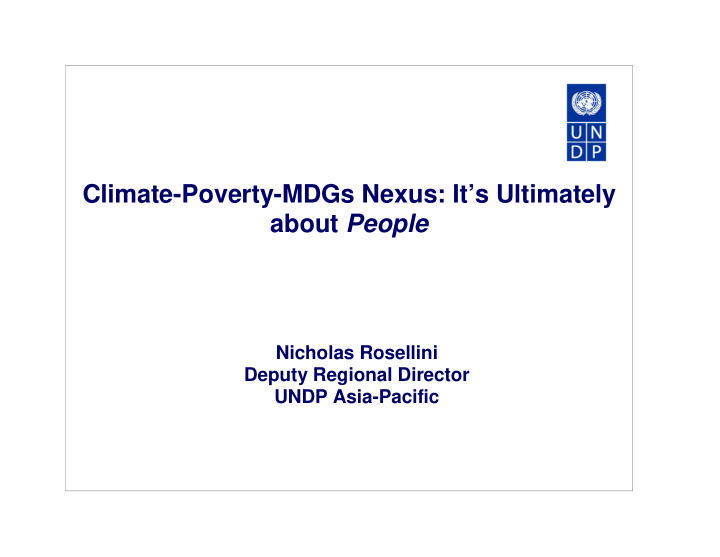



Climate-Poverty-MDGs Nexus: It’s Ultimately about People Nicholas Rosellini Deputy Regional Director UNDP Asia-Pacific
The Purpose and Road Map Describe: climatic changes and the transmission • mechanisms that ultimately link to poverty and human development (MDGs) Highlight broadly the links and impacts: to • employment and livelihoods, health, gender and security. Provide future direction: in terms of overall and specific • implications on the link between climate change and poverty/MDGs.
In Brief… • Climate change is a development challenge that will impact on MDG achievement • Responses have to be integrated, cut across traditional silos, and be long term • Rural and urban development strategies need to incorporate responses to the challenges
Cause…. • Green house gases (GHG) – Carbon dioxide • Fossil fuel use • Land use changes – Methane and nitrous oxide • Agriculture
….and effect • Trap radiations • Warming – Air and ocean temperatures up – Snow and ice melting – Average sea level rise
Three paths of impacts • Long term changes in averages – Temperature – Precipitation – Sea levels • Changes in variability – More weather variation from year to year • Droughts and floods • More frequent, and worse extreme weather events • Hurricanes
Each has implications for PR/MDGs… Six human development tipping points • Reduced agricultural productivity • Heightened water scarcity • Increased exposure to extreme weather events • Collapse of ecosystems • Increased health risks • Increased risks & economic and social vulnerability of affected countries and within countries Source: Modified from Human Development Report, 2007/2008; Fighting Climate Change – Human Solidarity in a Divided World
The Climate-Poverty-Development Nexus Variability in temperature, rainfall Average changes in temperature, and extreme events rainfall and sea-levels Slow onset, Floods, continuous hazards droughts, Heat e.g. desertification waves, Coastal Impact on storms, etc. Ecosystems: Ecosystem services & freshwater resources damaged or degraded. Impact on Sectoral Output: Macro- Direct Impact: economic Assets, property Impact destroyed; lives lost Impact on Poverty and MDGs
Impacts on economic and social aspects Spatial level impacts: Sectoral level impacts: Macro level impacts: • Vulnerable regions (coastal, • Lower outputs of energy, food, • Reduced GDP growth rates; arid etc.) and water supply. Degraded government budgetary • Urban areas public service provision water revenues, employment; trade; supply and sanitation, health rising food and energy prices. services, food availability, etc. Household (HH) level impacts: (with differential impacts on women and children) • Loss of income from off-farm employment • Loss of income losses from agriculture, fishing and livestock • Reduced production of subsistence crops and Natural Resource food products • Loss of public services e.g. water and sanitation; education; safety nets; micro-finance And ultimately broader MDGs • Malnutrition, increases in infant and child mortality, changes in school attendance, poorer health outcomes and life expectancy, and increasing social and political tension. • Vulnerability: some households pushed back into poverty or fall further into poverty
Overall implications for Poverty and MDGs • Building on what has been learned from “multiple” crises impact (such as global economic recession) • Intrinsic need for cross-disciplinary/sectoral/agency response– silo-ed Business as Usual will not work • Shifting development paradigm to “pro-poor” climate resilient development: – Moving beyond just short-termism and ensuring long term societal transformation that takes into account the changing nature of climate shocks and stresses
Specific implications for PR/MDGs • Promoting and sustaining “pro-poor” “green” climate resilient growth that: – Ensures low carbon [technology] investments and green jobs – Generates revenues for ‘climate-proofing’ public (poverty reduction/MDG) investments, – Allows new opportunities for economic diversification; • Investing in building assets of the poor – natural, financial, human – and providing access to modern energy services to maintain welfare gains and providing choices for autonomous adaptation. • Investing in new interventions in some countries (e.g. protection against malaria where not needed before).
Specific implications for PR/MDGs • Increasing emphasis and investments on social protection to promote diversification and build resilience. • Designing new instruments that enable effective risk sharing across households and communities. • Providing private sector, an important contributor to growth and poverty reduction, with additional support (e.g. for the adoption of new technologies) to adapt and grow. • Linking Climate finance to the achievement of poverty reduction and the MDGs
Some Examples… • Country level – Uganda – Cambodia • Local Governance – Local climate planning – Climate proofing pro-poor infrastructure • Indigenous Peoples • Gender
Thank you
Recommend
More recommend